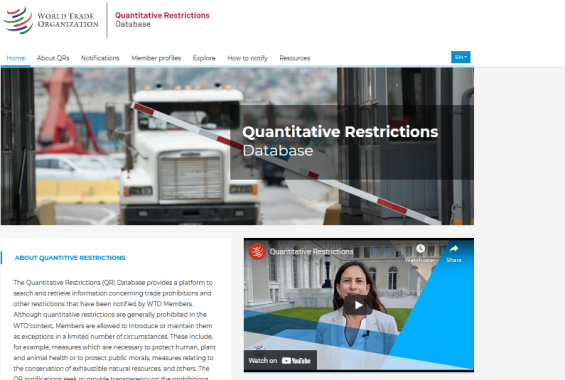- The improved Quantitative Restrictions (QR) Database is an online platform to search and retrieve information on trade restrictions and prohibitions notified by WTO members
- As of November, 84 members have submitted 220 QR notifications to the WTO
- These notifications encompass 1,724 notified measures that are currently in force, with 62% applying to imports and 38% to exports
- Pandemic-related export prohibitions and restrictions account for 60 measures that have been notified by 34 members
The World Trade Organization (WTO) launched on November 8 an improved Quantitative Restrictions (QR) Database, an online platform to search and retrieve information on trade restrictions and prohibitions notified by WTO members.
The QR Database provides information on export prohibitions and restrictions introduced by members in response to the COVID-19 pandemic, with detailed information on the affected products, the intended duration of the measures and their WTO justification.
The improved database makes it easier for the user to access information contained in the QR notifications and also gives the possibility of generating charts directly through the platform, said the WTO.
Quantitative restrictions are regulated by Article XI of the General Agreement on Tariffs and Trade 1994 (GATT 1994), which provides for the general elimination of all “prohibitions or restrictions other than duties, taxes or other charges” on imports and exports of goods, which can be “made effective through quotas, import or export licences or other measures.“
Although QRs are generally prohibited, they may be allowed as exceptions in a limited number of circumstances, the WTO explained. These QRs include measures which are necessary to protect human, plant and animal health or to protect public morals, and measures relating to the conservation of exhaustible natural resources.
The QR notifications seek to provide transparency on these prohibitions and other restrictions, as well as their legal justification under WTO rules. The QR Database can be accessed here.
As of November this year, 84 WTO members have submitted 220 QR notifications to the WTO. These encompass 1,724 notified measures that are currently in force, with 62% applying to imports and 38% to exports. Although the name “quantitative restrictions” may suggest that these measures have a “quantitative” or “numerical” component, in fact only seven measures impose an absolute limit on the volume of a product that can be traded. These measures mainly take the form of non-automatic licenses (43%), prohibitions or bans (33%), and prohibitions except under defined conditions (21%).
Most of the notified QRs have been justified by members as measures necessary to protect human, animal and plant life or health, or relating to the conservation of exhaustible natural resources. The most cited WTO provision to justify such measures is Article XX:b of the GATT 1994.
Many members have also stated that these measures have been implemented in line with international conventions, such as the Convention on international trade in endangered species of wild fauna and flora (CITES), the Montreal Protocol on Substances that Deplete the Ozone Layer, and the Basel, Rotterdam and Stockholm Conventions’ three international environmental agreements.
Regarding the response to COVID-19, pandemic-related export prohibitions and restrictions account for 60 measures that have been notified by 34 members under the QR Decision as of October 4, 2021.









